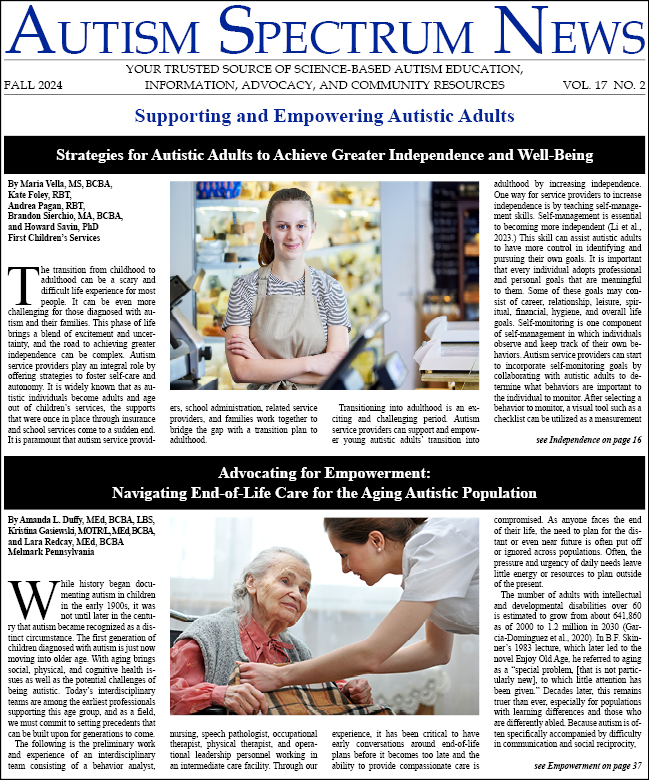Graduating from high school and transitioning to the world of work is an extremely important and exciting milestone. However, for many young adults with autism obtaining and maintaining employment can present some unique challenges. Unfortunately, despite the vastly increasing numbers of individuals being diagnosed with autism spectrum disorder (ASD), adult services for this population are seriously lacking (Debevois, 2008; Hillier et al., 2007). Many autistic young adults remain unnecessarily dependent on family members, unable to reach their full potential. They often live at home, are unemployed or underemployed, or participate in programs that are inappropriate, leaving many parents worried about what the future holds for their adult child. This is in spite of the fact that autistic individuals bring many strengths to the workplace such as attention to detail, trustworthiness, reliability, and low absenteeism (Howlin, Jordan, & Evans, 1995; Morgan, 1996). In addition, aspects of jobs that other employees may find unattractive including social isolation or repetitiveness often appeal to persons with ASD (Van Bourgondien & Woods, 1992).

Although demands for employment services for adults with autism are increasing substantially, currently there are few specialized services available and not much is known about how best to support those with autism in achieving success. However, there are some strategies which may help empower autistic young adults to achieve rewarding, satisfying employment and make meaningful contributions to their community and society as a whole. Strategies discussed here will emphasize the fundamentals, or “employment philosophies,” such as helping the individual realize what employment actually means, what jobs are like, and some of the realities of employment. These issues are critical for helping the young adult understand the importance of employment and the magnitude of the role it will (hopefully) play in their life.
Successful Employment: Preparation
Understanding the purpose of employment is critical for ensuring enthusiasm and motivation for the transition to the world of work. If an adolescent with autism does not fully grasp the fundamentals such as how important getting a job is going to be for them and why, a successful transition will be much harder to achieve. For an adolescent who is used to having many of their needs met by their parents, the idea of having to get a job is often not particularly appealing and may not seem to be something urgent. Many adolescents with autism may be reluctant to even think about life after high school when everything will change and there will be even greater expectations of them. Spending time thinking about some of the philosophy behind employment such as why it is important to have a job, what it means to have a job, what an employer is looking for in an employee, why being “independent” is important, etc., will be critical.

Ashleigh J. Hillier, PhD
Building a positive attitude and excitement towards getting a job is also important. The young adult can be reminded of why this transition is so positive, e.g., they will have their own money, they will meet new people, they will learn new skills, they will have something to do during the day, they will increase their self-confidence and improve their self-image, etc. Employment can be talked about as something which will be exciting and the individual will enjoy. Making plans for the future and identifying goals the adolescent would like to reach and how these goals can be achieved will help maintain enthusiasm for employment and also serve as a reminder that they need to be realistic in their employment expectations.
It is also important that the young adult with autism has opportunities to gain insight into the huge variety of job options available and what these jobs are like. Adolescents can be encouraged to consider what career paths may suit them well before high school graduation. Due to the abstract nature of imagining what a particular job would be like, it can be difficult for anyone to decide what might be a good match for them regarding employment. Constant observation of what other people are doing while you are out and about can be helpful. This exercise can help the adolescent recognize the huge variety of possible jobs (e.g., sales clerk, manager, construction worker, engineer, librarian, etc.). Whilst observing others or engaging in activities questions can be asked such as: “What jobs are involved when I go to McDonalds?” – the cashier, the cooks, their managers, where the food comes from – farms, processing plants, designing and manufacturing the packaging, building the restaurant, corporate management of the business / franchise, jobs in the banks that provide the financing etc.; “What jobs are involved in making this computer and getting it to me?” – designing the computer, manufacturing the parts to the computer, buying the parts from other companies that go in to the computer, software design, managing the people that do these jobs, sales and marketing, accounting, advertising, shipping, retail, etc. The adolescent can be encouraged to ask themselves questions such as, “What would these jobs be like and how would I get a job like that?”
Another useful strategy is simply asking people the young adult meets (including friends and relatives) questions about their job such as, “How did you get your job; What do you like / dislike about it; What qualifications do you need; How much do you get paid (if appropriate).” People the adolescent knows may be willing to have them visit their worksite for a job-shadowing experience where they observe that person at work for a couple of days. This will help enormously in exposing the individual to a variety of jobs (not only the individual they are shadowing but all the others who also work there), work environments, and realities of employment. Better still, actually volunteering at a company or organization will enable them to get hands on experience themselves in trying out different jobs. In addition, they can record these experiences on their resume and have sources for obtaining references. Even if the volunteer experience is not a great match to the adolescent’s interests, they can learn a variety of skills that would be applicable to any job such as responsibility, punctuality, reliability, interacting and communicating with others, and some of the realities of work such as having to do tasks which are less enjoyable, having to do things the way other people tell you to, only taking breaks at specific times, rules of the workplace such as no personal phone calls, no internet, etc.
Regarding the job application process itself, after some practice, searching for jobs, completing application forms, and preparing an eye-catching resume should not pose particular problems for individuals with autism. The internet provides some very useful resources in these areas and beyond including free job interest inventories, statistics on various job categories such as typical salary and necessary qualifications, lots of examples of resumes, job hunting tips, as well as of course the websites for various companies and organizations where the individual may be interested in working. However, there are some potential obstacles specific to the communication and social skills challenges seen in autism that relate to the job application process. These may include coordinating the job search process, communicating with potential employers by telephone, and identifying and tapping the individual’s “social network” for employment leads (often the most successful approach to finding a job). Coordinating the job search process can be simplified by setting up a table with columns for job title applied for, when applied, how applied, contact person, follow up date, etc. Job seekers with autism can practice using the telephone by first calling relatives and others they know and slowly expanding this to individuals they know less well, perhaps the doctor’s office or hair salon, and finally to potential employers. A script can be implemented to help the conversation go smoothly and ensure the young adult gets all the information about the job or next steps that they need. A “spider-gram” type method can be used to help the young adult identify all the individuals in their immediate and expanded social network.
The job interview potentially poses the most significant challenge for autistic adults due to challenges in social skills and “mind reading.” For many individuals with autism, the job interview presents a critical block in achieving successful employment. Parents and family members can play an important role in conducting realistic mock job interviews with the young adult where they can practice appropriate behavior and how to answer typical job interview questions such as, “Why do you want this job?” “Why should I hire you and not someone else?” “What are your strengths / weaknesses?” etc.
Successful Employment: Strategies in the Workplace
Once the young adult with autism begins their job it may be useful for them or their supervisor to distribute a brief handout to co-workers describing autism and some of the strengths and challenges the individual may present with. This will help co-workers understand the behavior of the young adult and perhaps be more supportive. Identifying a co-worker who can serve as a “mentor” is also a useful strategy. Supervisors can be asked whether there are any employees who are familiar with autism or other types of neurodiversity who might be willing to serve in this role. This person can serve as an initial “go to” person when the young adult needs advice or if problems arise. They can also help them to integrate socially into the workplace which is critical for job retention and job satisfaction.
Providing supervisors with specific strategies for supporting the employee will also be helpful. Although many more employers will be more familiar with the term autism than in the past, they may have little idea of how to best support someone with autism in the workplace. Strategies used in the classroom remain extremely useful and are often easily adapted to the workplace. For example, supervisors can be encouraged to:
- Clearly define the job task and what exactly is expected of the individual.
- Break tasks down into smaller components if possible.
- Provide immediate and honest feedback on their performance.
- Minimize verbal instructions (perhaps provide written instructions) and allow time to respond.
- Provide models of the specific job skill.
- Allow the individual to complete one task before beginning another.
- Provide checklists and timelines for when and in what priority tasks should be done.
- Provide a strategy to communicate when they need help or have not understood.
- Remember the individual may have difficulty interpreting body language, reading between the lines, sarcasm, etc., so clear communication is critical.
- Be sensitive to resistance to change and provide as much routine and predictability as possible.
- Be sensitive to any sensory issues the individual may experience that interferes with their work.
- Explain the authority hierarchy (help avoid individual potentially being taken advantage of by co-workers).
- Encourage social interactions with co-workers.
- Explain the formal and informal rule structure of how things work at that job site.
- Explain unwritten rules of the workplace (these are often social and impact being accepted by co-workers, which ultimately impacts job retention).
Meeting and communicating with other autistic adults can also be helpful during this transition. Others with autism can provide advice and discuss their employment experiences from a neurodiverse perspective and help the individual realize they are not alone in the challenges they may experience. Finding social groups for young adults with autism can be difficult but they are increasing in number. Also, email chat groups on the internet can be found easily.
Building a career comes with positive and negative experiences for everyone. Reminding the young adult that mistakes and failures are useful learning experiences may help them maintain a positive attitude towards employment when things don’t go according to plan. Quitting jobs, declining jobs, and sometimes even accepting jobs, can result in negative consequences, but these too can be seen as important lessons for future decision making.
Sometimes seeing their child transition to the world of work can be difficult for parents too. However, it is important at this time in their life to allow the individual to become more independent, and to treat them as the adult they are. Allowing the young adult to make their own decisions and choices – with the guidance of others – will help ensure their employment success in the future and throughout their career.
Summary
Transitioning to employment is an exciting time in an adolescent’s life. However, for many with autism this transition can come with challenges and unfortunately there are currently few support services available to help them. However, a variety of different strategies can be implemented to help make this transition as smooth and positive as possible. These include preparing early and thoroughly particularly focusing on the fundamental “employment philosophies” such as the purpose and realities of employment, what different jobs exist and what they are like. Once employed, often strategies that may have been used in the classroom can be adapted and implemented in the workplace. We hope that as society increasingly recognizes the assets an autistic employee can bring to the workplace, more vocational supports will be made available. We look forward to rewarding employment becoming a reality for every adult with autism, empowering them to contribute to their communities and the larger society.
Ashleigh J. Hillier, PhD, is Professor of Psychology at University of Massachusetts Lowell and Co-Director of the Center for Autism Research and Education (CARE).
References
Debevois, K. (2008). Letting go: Transitioning your adult child to independent living. Autism Advocate, 51, 8-14.
Hillier, A., Campbell, H., Mastriani, K., Izzo, M. V., et al. (2007). A two-year evaluation of a vocational support program for adults on the autism spectrum. Career Development for Exceptional Individuals, 30, 35-47.
Howlin, P., Jordan, R. R., & Evans, G. (1995). Module 3, Unit 3: Distance education course in autism (adults). Birmingham, UK: University of Birmingham, School of Education.
Morgan, H. (1996). Underpinning philosophy in the provision of services for adults with autism: A critique of global values related to specific practice. In H. Morgan (Ed.), Adults with autism: A guide to theory and practice (pp. 31–52). Cambridge, UK: Cambridge University Press.
Van Bourgondien, M. E., & Woods, A. V. (1992). Vocational possibilities for high functioning adults with autism. In E. Schopler and G. B. Mesibov (Eds.), High functioning individuals with autism (pp. 227–239). New York: Plenum Press.





[…] of life, self-esteem, and well-being. It’s a goal to work towards, but how do we break down the transition to employment into manageable […]